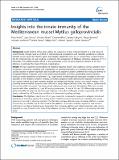Por favor, use este identificador para citar o enlazar a este item:
http://hdl.handle.net/10261/32962COMPARTIR / EXPORTAR:
 SHARE SHARE
 CORE
BASE CORE
BASE
|
|
| Visualizar otros formatos: MARC | Dublin Core | RDF | ORE | MODS | METS | DIDL | DATACITE | |

| Título: | Insights into the innate immunity of the Mediterranean mussel Mytilus galloprovincialis |
Autor: | Venier, Paola; Novoa, Beatriz CSIC ORCID; Figueras Huerta, Antonio CSIC ORCID | Fecha de publicación: | 26-ene-2011 | Editor: | BioMed Central | Citación: | BMC Genomics 12: 69-87 (2011) | Resumen: | [Background]: Sessile bivalves of the genus Mytilus are suspension feeders relatively tolerant to a wide range of environmental changes, used as sentinels in ecotoxicological investigations and marketed worldwide as seafood. Mortality events caused by infective agents and parasites apparently occur less in mussels than in other bivalves but the molecular basis of such evidence is unknown. The arrangement of Mytibase, interactive catalogue of 7,112 transcripts of M. galloprovincialis, offered us the opportunity to look for gene sequences relevant to the host defences, in particular the innate immunity related genes. [Results]: We have explored and described the Mytibase sequence clusters and singletons having a putative role in recognition, intracellular signalling, and neutralization of potential pathogens in M. galloprovincialis. Automatically assisted searches of protein signatures and manually cured sequence analysis confirmed the molecular diversity of recognition/effector molecules such as the antimicrobial peptides and many carbohydrate binding proteins. Molecular motifs identifying complement C1q, C-type lectins and fibrinogen-like transcripts emerged as the most abundant in the Mytibase collection whereas, conversely, sequence motifs denoting the regulatory cytokine MIF and cytokine-related transcripts represent singular and unexpected findings. Using a cross-search strategy, 1,820 putatively immune-related sequences were selected to design oligonucleotide probes and define a species-specific Immunochip (DNA microarray). The Immunochip performance was tested with hemolymph RNAs from mussels injected with Vibrio splendidus at 3 and 48 hours post-treatment. A total of 143 and 262 differentially expressed genes exemplify the early and late hemocyte response of the Vibrio-challenged mussels, respectively, with AMP trends confirmed by qPCR and clear modulation of interrelated signalling pathways. [Conclusions]: The Mytibase collection is rich in gene transcripts modulated in response to antigenic stimuli and represents an interesting window for looking at the mussel immunome (transcriptomes mediating the mussel response to non-self or abnormal antigens). On this basis, we have defined a new microarray platform, a mussel Immunochip, as a flexible tool for the experimental validation of immune-candidate sequences, and tested its performance on Vibrio-activated mussel hemocytes. The microarray platform and related expression data can be regarded as a step forward in the study of the adaptive response of the Mytilus species to an evolving microbial world. | Descripción: | 19 páginas, 5 figuras, 3 tablas.-- Paola Venier ... et al. | Versión del editor: | http://dx.doi.org/10.1186/1471-2164-12-69 | URI: | http://hdl.handle.net/10261/32962 | DOI: | 10.1186/1471-2164-12-69 | ISSN: | 1471-2164 |
| Aparece en las colecciones: | (IIM) Artículos |
Ficheros en este ítem:
| Fichero | Descripción | Tamaño | Formato | |
|---|---|---|---|---|
| 1471-2164-12-69.pdf | 5,42 MB | Adobe PDF |  Visualizar/Abrir |
CORE Recommender
PubMed Central
Citations
45
checked on 14-abr-2024
SCOPUSTM
Citations
161
checked on 12-abr-2024
WEB OF SCIENCETM
Citations
142
checked on 25-feb-2024
Page view(s)
409
checked on 16-abr-2024
Download(s)
355
checked on 16-abr-2024
Google ScholarTM
Check
Altmetric
Altmetric
Artículos relacionados:
NOTA: Los ítems de Digital.CSIC están protegidos por copyright, con todos los derechos reservados, a menos que se indique lo contrario.
